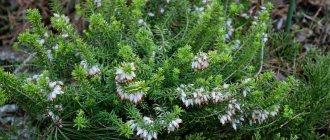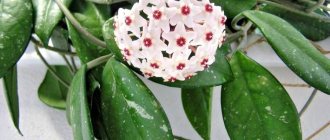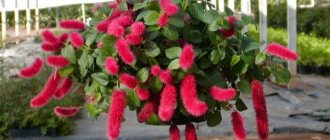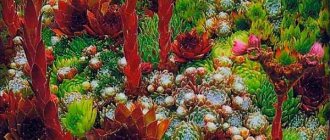Amorphophallus is a very unusual and interesting exotic plant, which in its natural environment grows in the tropical and subtropical zone, from West Africa to the Pacific Islands, in Cambodia, Indonesia, Malaysia, the Philippines, and Sri Lanka. It grows in nature in various places and is not particularly picky in choosing the soil and place of growth. The genus belongs to the Araceae family (Araceae, Arum) and is quite wide and diverse and includes more than 100 plant species, which range from small to giant. Amorphophallus are tuberous herbs that have a dormant period, but there are also evergreen specimens in its genus. The size of the tuber varies and can reach a weight of 5 kilograms.
The name of this exotic genus comes from two Greek words μορφος, “formless,” and φαλλός, “phallus, shoot, offspring.” In various countries, Amorphophallus is popularly called “Voodoo Lily”, “Snake Palm”, “Corpse Flower”, “Devil Flower”. It cannot be said that these names have nothing behind them, because when Amorphophallus blooms it emits a very unpleasant smell, but the main thing is to hold out for the first 3 days, then the smell weakens and soon disappears completely. In nature, this smell serves as a bait for insects, which serve as a pollination tool.
In nature, female flowers open earlier than male ones, and for pollination it is necessary for two plants to bloom almost simultaneously, with a difference of 2-3 days. If pollination has occurred, then in place of the flower a cluster of fleshy berries with seeds is formed, and the mother plant dies. Under indoor conditions, none of the cultivated species produces seeds.
Amorphophallus: what it looks like, what family it belongs to
Giant tropical flower
Among the 170 species of tropical and subtropical plants of the Araceae family, amorphophallus stands out - “shapeless phallus”, translated from Greek. It is a tuberous, deciduous plant that smells like rotten eggs and fish, but only gives off an "amber" when touched.
Hence the numerous names: corpse flower, amorphophallus snake palm, voodoo lily. One of the nicknames is the tongue of the devil.
The size of the plant can be from small (placed in a pot on the windowsill) to gigantic, for which special greenhouses are built. The culture grows from a spherical tuber, reminiscent of a beet or grapefruit, weighing up to 5 kg. Plants have a long dormant period, only some species are evergreen grasses.
Amorphophallus domestica is a short-lived ephemeroid. Every year, one leaf, dissected like a palm tree, grows from the tuber on a long petiole. It can be several meters wide and lasts throughout the growing season. The next season, the leaf blade becomes taller and even more dissected.
Important! The flower is not related to palm trees, as ordinary people mistakenly believe.
It blooms once per season - it produces an elongated oval ear, covered with inflorescences, from which round fruits with seeds then ripen. Color - orange-red, white, blue.
Flower in natural environment
Spreading:
- In the wild, lowland culture grows in the tropics and subtropics of Africa, Asia, and Australia.
- Can also be found on the islands of Java, Philippines, Fiji, Moluccas, Borneo.
- Widespread distribution of the world's largest amorphophallus flower is observed in India, China, Japan, and Bangladesh. It is also found in the countries of Laos, Cambodia, and Vietnam.
Most species grow on destroyed foundations - secondary forests, limestone rocks, weedy areas.
Varieties
How to grow amorphophallus - a flower at home
Several types are suitable for home cultivation:
- Amorphophallus konjac. In Asian countries, amorphophallus konjac is not a flower for decorative purposes. There, the bulbous tubers of the peony-leaved amorphophallus are used in cooking. They are ground into flour, from which side dishes, sauces, and seasonings are made. The dietary product (the taste resembles potato) helps those suffering from high blood sugar, cleanses the body of toxins, and fights obesity.
- Amorphophallus titanica or titanium. The greenhouse plant was obtained through selection. In appearance, it is a huge inverted bell measuring up to 3.5 m in diameter and up to 2 m in height. They grow a giant from a tuber weighing 20-25 kg.
- Bulbous variety. This amorphophallus resembles a houseplant more than other species. It is not tall - up to half a meter, the flower size is up to 30 cm, the spadix is evenly colored pink.
Important! The famous titanium variety is not suitable for home cultivation - it needs a special greenhouse with high air humidity.
Cognac variety
Features of home care
Scylla, indoor flower - planting and care
Owners of home flower beds compete to see who can grow the largest specimen. The size of the flower depends on the variety and inspection. The most important care rules are as follows.
Temperature
Large varieties kept in greenhouses require +25-28 °C during the period of intensive growth and flowering - conditions close to natural. For bulbous plants, a normal room temperature of +24 °C is sufficient.
After flowering, the pot is taken to a cool room - +10-13 ° C, or the thermometer in the greenhouse is lowered.
Lighting
In the wild, amorphophallus is a flower that grows under the cover of tall tropical forest vegetation, but there is plenty of sun and air. Houses also provide light, but diffused - on southern window sills, flower growers shade the plantings.
Watering
Constant moisture in the substrate is an important component of the active growth and development of the crop. But the water should not stagnate in the container, so good drainage is provided in the container. The tap liquid is allowed to settle so that the chlorine disappears.
Spraying
A mandatory daily procedure is to spray the leaf so that it does not begin to turn yellow at the edges. The water is settled and heated, otherwise the plant will get a shock.
In the greenhouse
Humidity
Air saturation with moisture is maintained by spraying from a spray bottle or automatically.
The indicator should be above average - 70-80%.
Priming
The soil is selected in agricultural stores - a universal flower substrate, or soil for Saintpaulias.
For reference! You can prepare the soil for exotics yourself by mixing turf soil, humus and sand in equal proportions.
Feeding
During the growing season, the flower crop is fed with mineral and organic compounds. The emphasis is on high phosphorus content. The plant spends a lot of energy on rapid growth and flowering, so it is fertilized every 10 days.
Trimming
The beauty of home greenhouses does not need to be trimmed. When a bud appears, it is pinched so that there is no unpleasant odor. The flower and leaf die naturally. Dried parts are removed before wintering.
Feeding
It is recommended to fertilize amorphophallus in the summer, when the plant has already grown well. Phosphorus must predominate in the fertilizer (for tuber growth), and the presence of nitrogen and potassium .
The plant responds well to organic fertilizers , in particular, to feeding with liquid mullein.
Mineral and organic fertilizing should be alternated.
Feeding should be mandatory, especially for flowering plants.
Fertilizers are applied only to moist, well-watered and slightly dried soil. Applying fertilizers to dry soil can burn the roots.
Amorphophallus blooming in the apartment
Features of care during the rest period
By autumn the flower stops growing and the leaf fades. Watering and fertilizing are gradually reduced, the leaf is cut off close to the ground.
Indoor bride flower - what is the name of the plant?
Amorphophallus remains in hibernation for 5-6 months. The tuber can be left in the pot. In a cool place, lightly spray the soil every 10-12 days.
If it is decided to extract the root, then shake it off the ground and remove damaged and rotten areas. There may be babies on the rhizome that are separated for reproduction.
The tuber is disinfected in a solution of potassium permanganate for 2-3 hours and dried.
For reference! For storage, place in a box, cover with sand or peat, and store in a dark, cool and dry place.
Growing rules
Amorphophallus is an unusual indoor plant, so before you bring it into your home, you should familiarize yourself with the cultivation rules. In many ways they are similar to the contents of bulbous plants.
Place
During the active phase, the flower needs good lighting, so the best option would be to place it on a south or east window. Despite the fact that under natural conditions the flower feels great under bright direct rays, when grown indoors this can cause burns. That is, on sunny days you will need shading. This can be achieved by installing a mesh or covering the glass with a translucent film that blocks ultraviolet radiation. Otherwise, not only will the leaf blade suffer, but flowering may not occur next season. If the lighting level is insufficient, it is necessary to use phytolamps or other light sources.
Temperature
The temperature regime depends on the phase. During the growing season, normal room temperature is required in the range of 18-26ºС. If the pot is taken outside or onto the balcony, then these indicators may be higher. Heat above 30ºC has a bad effect on growth and interferes with the growth of the corm.
Humidity
One of the characteristic features of representatives of the genus Amorphophallus is their requirement for air humidity. It should be at least 55%, otherwise the risk of the peduncle dropping or drying out of the buds increases. Spraying is needed throughout the growing season. To do this, you can use a spray bottle, mechanical or ultrasonic humidifier. You should spray distilled water, which will not leave white spots after drying. Another requirement is that such water should be no colder than room temperature, so as not to provoke the development of fungal diseases.
You can use another method: place stones or moss in a tray and periodically add water. The moisture will gradually evaporate and increase the humidity level in the room. Plants that stand outside do not need moisture; morning and evening dew are enough for them.
Watering
For irrigation use only softened water. It should be warm. During the growing season, amorphophallus is watered frequently, but between waterings the soil must dry out so that the tuber does not begin to rot. 20-30 minutes after watering, excess moisture is drained from the pan.
When watering, one important rule should be observed - you cannot pour water into the center of the pot, where the corm is developing. You can use bottom watering, that is, place the pot in a container with water, but you only need to immerse it 1/3, and keep it in this state for no longer than 5-10 minutes.
Bloom
The flowering of amorphophallus is a striking phenomenon. During the first few days there is an unpleasant smell, and for this reason the plant is called corpse flower. This effect, unpleasant for people, is necessary to attract pollinating insects, but when growing indoors, you will have to take the plant to the balcony or to a non-residential room until flowering is completed.
Some varieties of amorphophallus bloom for several days, others for a couple of months. Pollination is only possible when keeping several specimens, since male and female flowers open at different times.
If pollination has occurred and the fruit has ripened, the mother specimen dies completely and is no longer restored.
In place of the pollinated bud, berries develop. Their color can range from white to dark red.
Fertilizer
In order for the flower to accumulate the required amount of nutrients during its activity, amorphophallus must be fertilized. But they start this only after flowering has finished. To form a powerful tuber, use fertilizer with an emphasis on phosphorus. The ideal ratio of phosphorus, nitrogen and potassium is 4/1/1. You need to fertilize on wet soil. As soon as the first signs of leaf dying appear, fertilizing is reduced until next year.
Trimming
Pruning is needed twice a year: the first time - after the flower withers, the second time - after the foliage dies. For the procedure, take a sterile sharp instrument. It is forbidden to tear off shoots, because you can damage or completely pull out the tuber.
Transfer
Amorphophallus is transplanted in the spring before active growth begins. There is a special method of keeping it in winter - storing it without soil in the fall. Then planting occurs in March. The storage location should be moderately cool, dark and always dry.
Take a new container 4-5 cm more spacious than the previous one. In this case, the pot should not be too deep, since the root increases in width, and the lower part remains unused, and moisture can stagnate in it.
The corm is removed, freed from soil and carefully inspected. If there are spots of rot, they are carefully cut off with a sharp scalpel or knife. The injured area is immediately dusted with wood ash and left to dry for a day. If there are formed daughter tubers, they can be cut and planted separately to obtain new specimens.
When planting, a mixture for aroids is used, but it is recommended to improve it by adding vermiculite or perlite. Expanded clay is laid on the bottom in a layer of 5-6 cm so that excess water after watering can easily drain into the pan.
Seasonality
The key to success when growing is observing the periodicity of periods of activity and rest. This is the main difficulty of care, but if you take this feature into account, you can be confident of success.
The duration of the dormant period depends on the varietal characteristics and maintenance conditions. It can last from a month to six months.
The flower is usually purchased in the active phase, which lasts several months. When flowering ends, a leaf will appear, and then it will begin to lose the brightness of its color and wither.
You should not cut the petiole ahead of time; you need to wait until it dries thoroughly, otherwise the nutrients from living tissues will not have time to move to the root.
After dying, the pot can be moved to a place with minimal lighting and low temperature. Optimal values are 10-13ºС. At this time, all vital functions slow down, that is, spraying and fertilizing are not carried out.
Before the vegetative organs appear, the pot is again moved to its usual location with normal temperature conditions. Watering is resumed gradually, focusing on the speed of soil drying.
When and how does it bloom
The only flower appears before the leaf, pleases with its non-standard exotic appearance for 2 weeks. The tuber gives it a lot of nutrition, so it greatly decreases in volume. After flowering, the plant rests for 3-4 weeks, then forms a leaf.
The structure of the flower is complex:
- The inflorescences consist of an elongated corrugated or smooth spadix and a “spread.”
- The tube at the base is covered with scales or hairs - this is a trap for pollinating insects.
- A monoecious plant has staminate (male) and pistillate (female) flowers.
- At the end of the cob there is a horizontal or vertical sterile appendage.
Pollination occurs on the day the cob opens. The smell of decaying flesh attracts insects, which are caught in the cob's ingenious traps. They collect pollen from the staminate flower and transfer it to the female flower. Self-pollination is excluded, since female flowers open later than male ones. For the fruit to set, nature gave the snake tree amorphophalus one day.
Amorphophallus
Typical gardener mistakes
The main problems for a novice gardener are related to the need to adjust watering. In soil turned into a swamp, the amorphophallus tuber quickly rots. Other errors in care negatively affect the decorative appearance of a single leaf.
Table: how errors in care manifest themselves and what causes them
| What does the plant look like? | What is the reason |
| Quickly spreading black “wetting” spots on the tuber and at the base of the petiole. | Too frequent and/or excessive watering. The situation is aggravated by low indoor temperatures. |
| Drying leaf. | The plant does not have enough fertilizer or the air in the room is too dry. |
| Darkened leaf. | The flower does not have enough light. Sometimes it is placed in partial shade specifically to achieve this effect. |
| Light spots of irregular shape on the leaf. | Amorphophallus received sunburn. This happens especially often if a freshly sprayed plant is standing in the sun - drops of water focus the rays. |
How does amorphophallus reproduce?
The plant can be propagated using the usual gardener methods:
- Children. When the tubers are dug up and sent for winter storage, babies are discovered. They are broken off and placed in containers.
- By dividing the rhizome. In the spring, as soon as the first shoots appear, the bulb is dug up and divided into parts. Roots and growth buds should remain on each fragment.
The seed method is not rational. Seeds sown in containers with a suitable substrate germinate quickly - within 5-10 days. You need to care for it like ordinary seedlings. But flowering will occur in 5-7 years.
Tubers of a plant
Reproduction
Often, the “children” method is chosen for propagation. They appear near the leaf of an adult crop. If the growing conditions are favorable for the plant, then in one season the children can reach the size of the crop itself.
Amorphophallus can be propagated by another method. Many gardeners don’t even know that this method exists.
During the active period of the flower, a small process is located near the leaf (more precisely, near its divergences). It is barely noticeable, so housewives often do not notice it.
- When the leaf begins to dry out and the plant goes dormant, this tuber is separated from the mother trunk. The place that was attached to the leaf is dried.
- Plant the tuber in a small container. A sprout may appear instantly, or it may only do so in the spring. Each process behaves differently.
After reproduction, amorphophallus will develop within five years. It will begin to bloom only after complete adaptation. For this, the flower requires more time. Within five years, one leaf will form on the trunk. Sizes will be added annually.
After the culture is saturated with nutrients, the tuber grows up to thirty centimeters, and the first inflorescences begin to appear.
Transfer
As the snake tree grows, it is replanted using the transshipment method. This is done in early spring, when the sprouts are just appearing. The substrate is selected with the composition for aroid plants: peat, humus, leaf soil, sand.
Step-by-step description of the process:
- A thick layer of drainage is poured onto the bottom of the container.
- Fill the pot halfway with soil and add sand.
- The tuber is placed in the middle.
- Cover with the rest of the soil.
After transplantation, the plant is watered abundantly.
Important! The container should be 3 times the size of the tuber.
Spring Awakening
With the arrival of spring, the tuber needs to be removed from its hiding place and inspected for an increase in its growing point. If the tuber begins to develop, then it’s time to plant the Voodoo lily in the ground. If you are interested in how to transplant amorphophallus, pay special attention to the diameter of the tub: it should be three times larger than the diameter of the tuber being planted.
In wild conditions, the plant chooses soil saturated with limestone. You can please the “domesticated” amorphophallus by offering it soil with the following composition:
- sand;
- leaf soil;
- humus;
- peat;
- turf.
A quarter of the pot intended for the Voodoo lily should be filled with drainage. Do not throw away the remaining soil. During the entire growth period, soil will have to be added to the pot. From the moment of planting, you need to start watering the amorphophallus palm abundantly, remembering that high-quality watering and suitable humidity are the key to the full development of this representative of the tropical flora.
Babies can form on the mother tuber. Having discovered them, you should add soil and thus close them. Small “tubers” should under no circumstances be exposed.
Surprisingly, the snake palm easily reproduces in an ordinary city apartment. Knowing how to care for amorphophallus and having mastered the simple skills of watering and replanting, by the end of the flowering period you can become a happy “parent” of several tubers at once. In addition, a flower that is satisfied with its care generously produces seeds. To propagate the snake palm, you need to correctly extract the seeds from the ripened berries and plant them in the spring.
Diseases and pests
The tropical “guest” is resistant to diseases and pests characteristic of flowers. But from excess moisture, fungi, scale insects and nematodes appear. This explains why amorphophallus does not bloom. The soil is periodically disinfected from pests.
Aphids and spider mites may appear on the leaves - insecticides are used against them, as well as against scars, warty formations, and damage.
Rotten roots are removed before wintering so as not to infect the flower with pathogenic flora and bacterial infection.
The amorphophallus plant is a spectacular flower that surprises and gives great aesthetic pleasure with its appearance. Botanists consider it the largest flower in the world. Meanwhile, there are compact indoor specimens that are not difficult to care for: watering, light, correct temperature and humidity.











